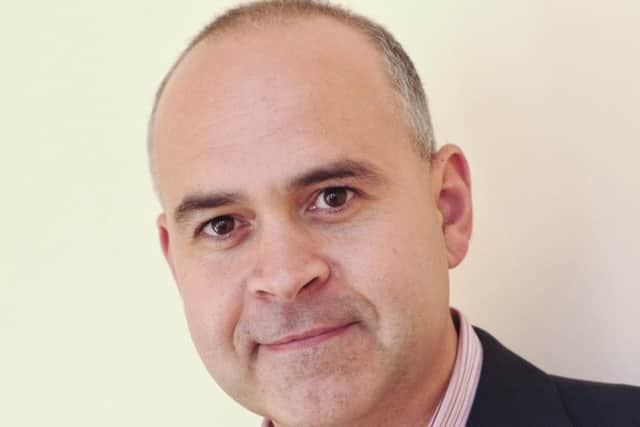Social media and young people: Are teens putting mental health at risk?


It can be a portal to a bigger, brighter, cooler place with around one quarter of young people admitting to populating social media almost constantly.
With a rush of messages, music, gossip and good-looking selfies, its easy to understand the attraction of viewing life through the social media prism.
Advertisement
Hide AdAdvertisement
Hide AdBut with the growing influence of advertising and marketing on social media channels, talk is emerging of the “blurred lines” between real life and its largely artificial twin created through sites such as Facebook and Instagram.
Dr Ewan Gillon, clinical director of First Psychology, which runs clinics across the country, said some young people may struggle to recognise this manufactured environment, sometimes with harmful results.
His comments also follow the high-profile crisis of Australian model Essena O’Neill, who quit the photo network Instagram - where she had 600,000 followers - before deleting most of her posts and declaring “social media is not real life.”
Dr Gillon, based in Edinburgh, said the competing realities could be problematic for some.
He said: “For younger people today, there is this blurring of lines between reality and constructed social media.


“Young people do not have the skill to stand back and distinguish between what is real and what is not, unlike perhaps the generations before them.
“One of the things I would be encouraging parents to do is be very clear to their children that it is a manufactured environment and enable their children to be able to stand back and recognise that.”
Dr Gillon said young people seeking support frequently spoke about the “complexity of the world” and the “different messages that they are juggling with.”
Advertisement
Hide AdAdvertisement
Hide AdHe added that, while these issues were not new, social media was now a strong influence when young people were finding a “sense of self” in their teenage years.
Dr Gillon added: “The difficulties that some people find is that it is really one-way communication.
“If you look at the people who engage with celebrities on social media, the communication by them is very controlled and managed.
“It is not an honest expression and that can be problematic.
“It can create an unreal, glossy version of life an does mask the difficulties of existence and people’s real lives.”
Dr Gillon said social media offered a channel for young people to express themselves, manage relationships and find information about problems they were experiencing.
He said its drawbacks were “quite numerous” but that the sheer scale of social media use meant that a “one size fits all” view was impossible.
He added: “There has been a very significant increase in children and young people attending clinics.
Advertisement
Hide AdAdvertisement
Hide Ad“That is, in part, due to mental health awareness. We have seen young people coming with issues of sense of self. Often, there is a social media element to it. It can, unfortunately, increase a sense of isolation and foster a sense of inadequacy.
“For younger people who are slightly more vulnerable, it can be very difficult that normal development process is being hijacked and disrupted by social media.
“Often the role of marketeers and the advertisers is not seen and manipulated. There is an element that is quite malevolent.”
In October, O’Neill, 19, deleted more than 2,000 pictures “that served no real purpose other than self-promotion”.
She edited the captions to the remaining 96 posts to reflect how she had distorted the reality of the post before making it public.
A photo of her wearing a bikini, once captioned “things are getting pretty wild at my house,” was changed to “see how relatable my captions were – stomach sucked in, strategic pose, pushed up boobs.”
She added: “I just want younger girls to know this isn’t candid life, or cool or inspirational. It’s contrived perfection made to get attention.”
O’Neill went on to post an emotionally charged confessional about the effect social media on her wellbeing on You Tube and has since set up a new website to promote “veganism, plant-based nutrition, environmental awareness, social issues, gender equality, [and] controversial art.”
Advertisement
Hide AdAdvertisement
Hide AdWhile some have praised her honesty, others have queried the motives behind her denunciation of her social media self.
Scottish singer Tallia Storm, 17, has used social media to promote herself since she was in her early teens and said it had been “hugely important” in the development of her identity and performance career.
She said she did not recognise the version of social media presented by O’Neill.
Ms Storm said: “Quite frankly, I question her real motives - she knew what she was doing all along so why did it take her so long to suddenly change her mind?
“She did it for long enough and why didn’t she just close it down or stop? No – instead she chose to share a highly debatable topic on social media to the world – which is ironic – which propelled her to the international spotlight.
“So in fact, was this her intention all along? Call me sceptical but I just didn’t buy it from someone who has invested so much time and energy on her Instagram and then jumping ship. Maybe she had too much time on her hands but I think it’s a tad hypocritical.”
What O’Neill did do, however, was highlight how much money she could make by endorsing products on her social media accounts, claiming she could “easily” raise around £1,000 a day from passing products off as ones which she would choose herself.
While using celebrities to advertise brands is nothing new, the use of social media makes the relationship between the product and the individual far more powerful - and far more personal.
Advertisement
Hide AdAdvertisement
Hide AdPop superstar Rihanna has heavily endorsed MAC cosmetics on her Twitter account, which has 53.5m followers - a far greater audience than any expensive television advertising or magazine circulation could reach. Her new sock range for Stance is also pushed with the seemingly personal message “upgrade yo sock game, bad gal x”
Tennis player Maria Sharapova has partnered with Nike and TAG Heuer to promote their brands to her 1.9 million followers and 15 million Facebook fans, making her one of the most sought after athletes by advertisers.
Dr Steve Smith, mental health lecturer at Robert Gordon University in Aberdeen, said young people had always sought to follow their idols, but that today they needed to have greater awareness of the relationship between social media and advertising.
He said: “When young people are following their idols, naturally they want to emulate them but they probably won’t be aware that these social media accounts are being run by marketeers.”
Dr Smith added it was part of developing an identity to identify with heroes - but that the “explosion of social media marketing towards teenagers was a new aspect of this.”
He said: “In the 1950s and 1960s people were emulating Doris Day, in the 1980s it was the New Romantics.
“Social media really only exacerbates the problems of adolescence. But it definitely doesn’t create them.”